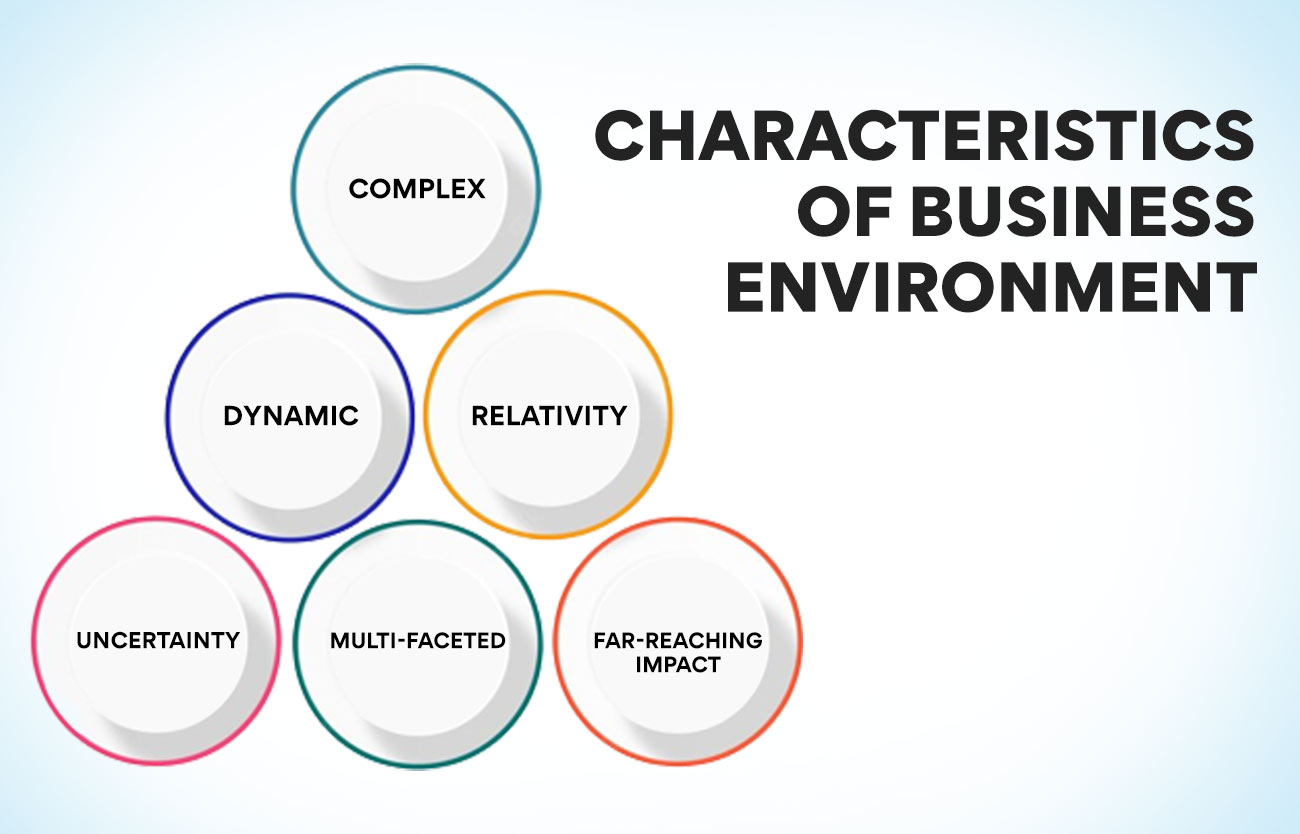Characteristics of a Business Environment

The characteristics of a business environment reflect its inherent qualities and attributes that shape the conditions under which businesses operate. These characteristics provide insights into the nature of the environment and help organizations adapt to its complexities. Here are key characteristics of a business environment:
-
Dynamic Nature:
- The business environment is dynamic, meaning it is subject to constant change. Factors such as technological advancements, market trends, and regulatory shifts contribute to its dynamic nature. Businesses need to stay responsive and adaptable to thrive in this ever-changing environment.
-
Complexity:
- The business environment is characterized by complexity due to the presence of various interrelated factors. Economic, social, political, technological, and cultural elements interact in intricate ways, creating a complex and multifaceted landscape that businesses must navigate.
-
Uncertainty:
- Uncertainty is an inherent characteristic of the business environment. Businesses often face unpredictability in economic conditions, consumer behavior, and regulatory changes. Coping with uncertainty requires strategic planning, risk management, and flexibility.
-
Interconnectedness:
- Different elements of the business environment are interconnected. Changes in one aspect can have cascading effects across various sectors, industries, and geographic regions. The interconnectedness of the global economy further amplifies this characteristic.
-
Competitiveness:
- Competitiveness is a defining characteristic of the business environment. Organizations constantly vie for market share, customer attention, and resources. The competitive forces influence strategic decision-making, innovation, and overall business performance.
-
Opportunities and Threats:
- The business environment presents both opportunities and threats. Opportunities arise from emerging trends, changing consumer preferences, and technological advancements. Simultaneously, threats may include economic downturns, regulatory challenges, or increased competition.
-
Legal and Regulatory Influence:
- The legal and regulatory framework shapes the operational environment for businesses. Governments enact laws and regulations that organizations must comply with. Understanding and adhering to these legal aspects are crucial for ethical and lawful operations.
-
Social and Cultural Factors:
- Social and cultural factors, such as demographics, values, and lifestyle trends, influence consumer behavior and market dynamics. Businesses must consider these factors to tailor their products, services, and marketing strategies to meet societal expectations.
-
Technological Advancements:
- The rapid pace of technological advancements is a key characteristic of the business environment. Innovations in technology influence how businesses operate, interact with customers, and stay competitive. Organizations that embrace and leverage technology gain a competitive edge.
-
Economic Forces:
- Economic factors, including inflation rates, interest rates, and GDP growth, have a significant impact on business operations. Economic conditions influence consumer purchasing power, investment decisions, and overall market stability.
-
Environmental Sustainability:
- Growing environmental awareness has led to a focus on sustainability in the business environment. Organizations are under pressure to adopt environmentally friendly practices, reduce their carbon footprint, and engage in corporate social responsibility (CSR) initiatives.
-
Globalization:
- Globalization has transformed the business environment by facilitating cross-border trade, investment, and collaboration. Organizations must consider global market dynamics, international competition, and geopolitical factors as they operate on a global scale.
-
Stakeholder Influence:
- Various stakeholders, including customers, employees, investors, suppliers, and communities, exert influence on businesses. Managing relationships with these stakeholders is essential for maintaining trust and garnering support.
-
Innovation and Creativity:
- The business environment encourages innovation and creativity as organizations seek to differentiate themselves. Embracing a culture of innovation is essential for businesses to stay ahead in a competitive market.
-
Cyclical Nature:
- Certain aspects of the business environment, such as economic cycles, follow cyclical patterns. Businesses must be attuned to these cycles and adjust their strategies accordingly to navigate periods of growth and contraction.
Understanding these characteristics helps businesses navigate the complexities of the environment, make informed decisions, and formulate strategies that align with the prevailing conditions. Organizations that proactively adapt to these characteristics are better positioned for sustained success.
Thank you,
